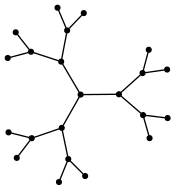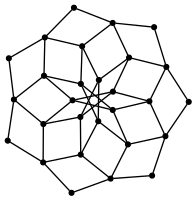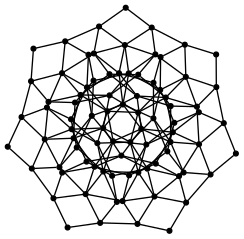A lower bound on the radius of a graph
Description of the problem
Assume we have an undirected graph \(G\) given as a pair of sets \((V,E)\) where \(V\) is a finite set of vertices and \(E\subset \binom{V}{2}\) is a collection of subsets of \(V\) each of size 2 denoting the set of edges.
The distance between two vertices is the length of the shortest path between these vertices. Eccentricity of a vertex is defined to be the largest distance from that vertex.
\[ Ecc(x) = \max_{y\in V} d(x,y) \]
Now, we can define the radius and diameter of a graph as
\[ Rad(G) = \min_{x\in V} Ecc(x) \text{ and } Diam(G) = \max_{x\in V} Ecc(x) \]
Today, I would like to find a lower bound on the radius of \(G\) by calculating two cheaper quantities: the number of vertices and the largest degree in the graph. The degree of a vertex is the number of edges connected to that vertex.
Eccentricity
Here is an algorithm that I used earlier to calculate the eccentricity of a vertex \(x\):
Function Eccentricity
Input: A vertex x and a graph G
Output: Eccentricity of x in G
Begin
Initialize R = 0
Initialize W = {x}
Initialize V = Vertices of G \ {x}
While V is non-empty
Let W = the intesection of V and the set of
vertices adjacent to a vertex in W
Let V = V \ W
Increase R
End while
Return R
Endwhich I re-implemented in common lisp as follows:
(defun vertices (H)
(remove-duplicates (reduce #'append H)))
(defun eccentricity (x G)
(labels ((vicinity (u)
(delete u
(remove-duplicates
(vertices
(remove-if-not (lambda (e) (member u e)) G))))))
(let* ((A (vertices G))
(size (length A)))
(do ((n 0 (1+ n))
(V (delete x A) (set-difference V W))
(W (vicinity x)
(intersection V (mapcan #'vicinity W))))
((or (null V) (> n size)) n)))))VERTICES
ECCENTRICITYFor this implementation, a graph is represented as a list of edges where and edge is a list that contains two vertices. Using this implementation, now I can define the radius as:
(defun radius (G)
(reduce #'min (mapcar (lambda (v) (eccentricity v G)) (vertices G))))RADIUSLet me test this on the following tree
(defvar tree '((-3 -1) (-4 -1) (-5 -2) (-6 -2) (-1 0) (-2 0) (0 1)
(1 2) (1 3) (2 4) (2 5) (3 6) (3 7) (4 8) (4 9) (5 10)
(5 11) (6 12) (6 13) (7 14) (7 15)))TREE
(mapcar (lambda (v) (eccentricity v tree)) (vertices tree))
(radius tree)(6 6 6 6 5 5 4 3 4 4 6 5 6 6 5 6 6 5 6 6 5 6)
3A lower bound on the radius
In the first step of the eccentricity algorithm, we delete one vertex. Assume we have $ k = _{vV} deg(v) $. Then in the second step we remove \(k\) vertices. Then at each next step, the number of edges we deleted is multiplied at most by \(k-1\). Let us assume \(|V|>2\) and therefore we can deduce \(k>1\). We distinguish two cases: (i) \(k=2\) and (ii) \(k>2\). For the first case
\[ |V| \leq 1 + 2 Ecc(v) \]
For the case \(k>2\) we obtain
\[ |V| \leq 1 + k + k(k-1) + \cdots + k(k-1)^{Ecc(v)-1} = 1 + k \sum_{i=0}^{Ecc(v)-1} (k-1)^i = 1 + k \frac{(k-1)^{Ecc(v)}-1}{k-2} \]
Playing with the equation, we get
\[ Ecc(v)\geq \frac{\log((|V|-1)(1-2/k)+1)}{\log(k-1)} \]
The inequality holds for every vertex \(v\). So, we get
\[ Rad(G) = \min_{v\in V} Ecc(v) \geq \frac{\log((|V|-1)(1 - 2/k)+1)}{\log(k-1)} \]
when \(k\geq 3\).
Examples
I am going to implement our approximation function as follows.
(defun approx (G)
(labels ((degree (x) (length (remove-if-not (lambda (e) (member x e :test #'equal)) G))))
(let* ((vertices (remove-duplicates (reduce #'append G)))
(k (reduce #'max (mapcar #'degree vertices)))
(n (length vertices)))
(cond
((< k 2) nil)
((= k 2) (floor (1- n) 2))
(t (ceiling (/ (log (1+ (* (1- n) (- 1 (/ 2 k)))))
(log (1- k)))))))))APPROXWe start with the complete graph on 5 vertices \(K_5\):

(radius K5)
(approx K5)1
1So, the inequality is actually an equality. For the binary tree we used earlier

we get
(radius tree)
(approx tree)3
3So, the inequality is tight in this direction too. On the other hand, for graphs of type \(A_n\) and \(C_n\), we have \(k=2\).

(radius A7)
(approx A7)4
4In other words, the inequality is still the best we can hope for for these graphs too.
Ok. Now, for a random graph:

(radius graph)
(approx graph)4
3An analysis
For highly connected graphs, the lower bound is going to be worse since we would be badly overestimating the number of vertices we deleted in each step of the algorithm. For example for the following graph we get

(radius graph1)
(approx graph1)6
3The complete graphs \(K_n\) are exempt from the overestimation since our algorithm terminates at step 1 already.